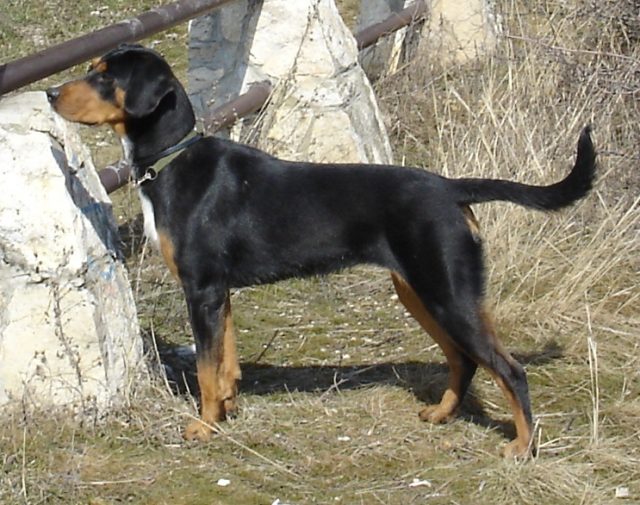Type the name of the breed you're looking for below
[wpdreams_ajaxsearchlite] Don't see the breed your're looking for? Click here and let us know!
Breed Characteristics
1 paw - breed exhibits the least amount of this characteristic
5 paws - breed exhibits most amount of this characteristic
Transylvanian Hound
| Other Names | Erdélyi kopó, Hungarian Hound, Transylvanian Scent Hound |
| Country of Origin | Hungary |
| Weight | Minimum of 55lbs. (25 kg) |
| Height (at withers) | 21.5 - 25.5 in. (55 - 65 cm) |
| Coat | The dense coat, although coarse, is shiny, and features both a topcoat of guard hairs and an undercoat of down hairs. The hairs are straight, and generally lie flat, although the coat may feature "cowlicks" and ridges. The entire body is covered in fur, including the belly. The coat is longer on certain parts of the body, particularly the neck, withers, back of the upper thigh, and underside of the tail. Both FCI and UKC standards consider divergent coats (whether wavy, wiry, soft, or sparse) to be faults. |
| Colour | Primarily black, with tan markings on the muzzle and legs, and "always" a tan point on each eyebrow, according to the FCI (the UKC standard is less strident on this point). The tan areas are clearly distinct from the black. White markings "may" appear on the nose, forehead, neck, chest, lower limbs, and tail tip, according to the FCI standard, which considers it "undesirable" for more than one fifth of the coat to be white. The UKC standard requires that the coat by tricolour, featuring both the tan and white markings on black, and is less specific about what constitutes an excessive amount of white. Both standards declare a brown or bluish base colour to be a fault. |
| Litter Size | 3 - 6 puppies |
| Life Span | 12 - 14 years |
| Origin & History | The ancestors of the Transylvanian Hound came with the invading Magyar tribes in the ninth century, who brought in hounds and crossed them with local varieties and with Polish hounds. The dog was the favourite of the Hungarian aristocracy during the breed's peak in the Middle Ages, for hunting various game animals. Two height varieties developed to hunt different game in different types of terrain, and both varieties were kept together. The long-legged variety was used for hunting woodland and grassland big game, such as European bison, bear, boar, and lynx. The short-legged variety was used for hunting fox, hare, and chamois is overgrown or rocky terrain. The breed declined, and was marginalised to the Carpathian woodlands, shrinking with the growth of agriculture and forestry. At the beginning of the twentieth century, the breed was nearly extinct, and not recognised and standardised by the Fédération Cynologique Internationale (FCI) until 1963. In 1968, efforts began to save it. Today, a substantial number of the long-legged variety of the dogs may be found in both Hungary and neighboring Romania. However, only the long-legged variety remains. The Transylvanian Hound is, naturally, recognised by the national dog breeding and fancier group, the Hungarian Kennel Club (using the FCI breed standard). The breed was recognised with a breed standard by one US-based group, the United Kennel Club (UKC), in 2006. The more prominent American Kennel Club publishes no standard for it, though the organisation at least provisionally recognises its existence, announcing its acceptance in 2015 into the AKC Foundation Stock Service Program, for breeders hoping to establishing it in the United States. |
| Personality | The breed is described by the FCI standard as "good-natured, courageous, enduring", with a basic character that is "quick, even, but also determined and lively", and the UKC standard uses similar terms. Properly trained, the dogs can hunt comparatively independently, and at a considerable distance from handlers, singly or in groups. Hunting behaviors exhibited by the breed include tracking (by scent), pointing, and driving game. The dog has a high-pitched, ringing bark. |
Care Requirements
| Health | There are no known breed-specific health concerns. |
| Grooming | This dog does not require a large amount of grooming. Their smooth short-haired coat is easy to look after. Owners will simply want to make sure the coat is brushed on a consistent basis. These dogs should only be given baths when they need it. A wipe down with a damp towel should suffice for the bathing aspect, (although you should bathe it with mild soap only if or when necessary; you should also dry shampoo it occasionally), however a rubber, wire, or hard bristled brush would work best for the brushing aspect. The shedding patterns of these dogs are not known. Be sure to check the ears carefully for signs of infection. The nails should also be trimmed, (particularly to avoid nail-born infections). |
| Exercise | This is a dog that needs extensive amounts of exercise. Without it, the dog could become problematic for its owners. It should be taken on walks daily, and this dog is great for healthy people who love to jog and hike. |
| Other Considerations | While it can live in an apartment, it may perform better in a small yard. It is important for owners to make sure this dog is never unleashed in an unsecured area, as it may run off in the direction of the first interesting scent it picks up. It is important for owners to make sure these dogs are given lots of space to move around in. |



